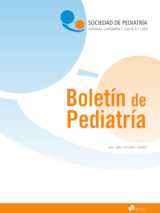Síndrome del espectro óculo-aurículo-vertebral: manifestación atípica de una patología infrecuente
O. Salcedo Fresneda , E. Fernández Morán , S. Rodríguez Ovalle , M. Muñoz Lumbreras , A. Alonso Alonso , B. Fernández Colomer
Bol. Pediatr. 2023; 63 (264): 123 - 125
Introducción. El diagnóstico del síndrome del espectro óculo-aurículo-vertebral (OAVS) se basa en los hallazgos fenotípicos al nacimiento. Presentamos este caso por su peculiar presentación clínica y su escasa frecuencia. Caso clínico. Recién nacido prematuro tardío con diagnóstico prenatal de cefalocele atrético que ingresa en la Unidad de Neonatología. A su llegada a la Unidad, se observan mamelones preauriculares bilaterales con posible fístula, aparente estenosis de los conductos auditivos externos, hipertelorismo, micrognatia, y un dermoide limbar en el ojo derecho. Se realiza resonancia magnética cerebral, que confirma el cefalocele atrético (no comunicante con el parénquima cerebral), con restos meníngeos y tejido neural degenerado en su interior, siendo intervenido con éxito a la semana de vida. Por otro lado, se amplían estudios radiológicos objetivando asimetría y estenosis de ambos conductos auditivos externos, conducto auditivo interno derecho doble y severa hipoplasia de las ramas ascendentes de la mandíbula que condicionan una importante micrognatia. El fenotipo del paciente junto con los hallazgos radiológicos, son compatibles con un OAVS. Comentarios. Resulta interesante el caso por la peculiar presentación clínica, ya que en la literatura consultada no hay ningún caso publicado con la particularidad de nuestro paciente, un cefalocele atrético. El OAVS constituye una entidad congénita poco frecuente, caracterizada por la asociación de anomalías oculares, auriculares, mandibulares y vertebrales, y cuya etiología permanece desconocida, presentando un diagnóstico clínico, según los criterios de Feingold y Baum. Su pronóstico y tratamiento es variable, en función de las manifestaciones acompañantes.
Oculo-auriculo-vertebral spectrum syndrome: atypical manifestation of an uncommon pathology
Introduction. The diagnosis of oculus atrial vertebral spectrum syndrome (OAVS) is based on phenotypic findings at birth. We present this case because of its peculiar clinical presentation and its low frequency. Clinical case. Late preterm newborn with prenatal diagnosis of atretic cephalocele cephalocele admitted to the Neonatology Unit. Upon arrival at the Unit, bilateral preauricular mamelons with possible fistula, apparent stenosis of the external auditory canals, hypertelorism, micrognathia, and a limbar dermoid in the right eye were observed. Brain MRI is performed, which confirms atretic cephalocele (not communicating with the cerebral parenchyma), with meningeal remains and degenerated neural tissue inside, being successfully operated on in the first week of life. On the other hand, radiological studies are expanded aiming at asymmetry and stenosis of both external auditory canals, double right internal auditory canal and severe hypoplasia of the ascending branches of the jaw that condition an important micrognathia. The patient’s phenotype, along with radiological findings, are compatible with OAVS. Comments. The case is interesting because of the peculiar clinical presentation, since in the literature consulted, there is no published case with the particularity of our patient, an atretic cephalocele. OAVS is a rare congenital entity, characterized by the association of ocular, auricular, mandibular and vertebral anomalies, and whose etiology remains unknown, presenting a clinical diagnosis, according to the criteria of Feigold and Baum. Its prognosis and treatment is variable, depending on the accompanying manifestations.
Artículo completo (PDF) (348 kb.)
- Neonatología
